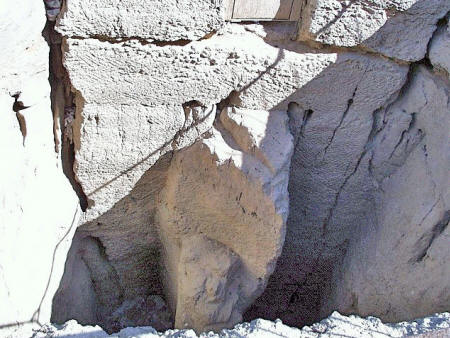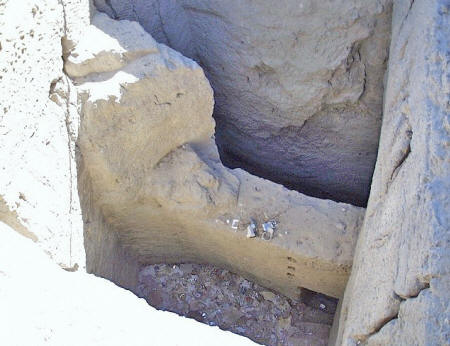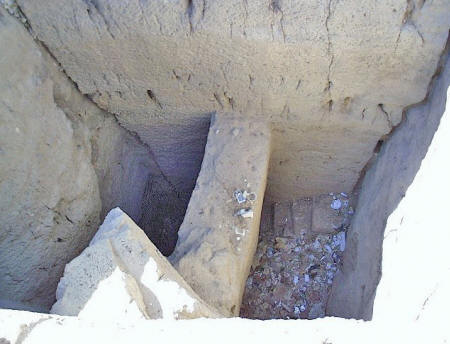|

from
GizaPower Website
The Discovery
Explorations within the Great Pyramid have revealed, for the first
time in modern history, the contents and features of the enigmatic
Southern Shaft in the Queen's Chamber. What other discoveries will
be found when the Egyptian government penetrates further into the
Great Pyramid's ancient confines?
The Queen's Chamber Southern Shaft was first discovered in 1872 when
Waynman Dixon detected a crack in the wall and was able to push a
rod through the crack for some distance without meeting any
resistance. This discovery prompted him to have Bill Grundy chisel
through the limestone to discover what lay behind. A full account of
this exploration and its implications is contained in
The Giza Power
Plant.
In 1993, there was a flurry of excitement around the world when
information was released about a remarkable discovery inside the
Great Pyramid. German robotics engineer, Rudolph Gantenbrink, who
had been contracted to install ventilation fans inside the pyramid,
received permission to design a robot to explore the shafts inside
the Queen's Chamber. Unlike the shafts leading from the King's
Chamber, these approximately eight-inch square shafts had no known
exit point on the outside of the pyramid. A complete and thorough
account of these explorations can be found at Gantenbrink's own
website at
http://www.cheops.org
The robot, named Upuaut II (meaning opener of the ways) was equipped
with lights, camera and laser pointer, and has received more fame
and recognition that any other similarly equipped explorer on the
subject. What the robot revealed to the world was a termination
point high in the body of the pyramid. The shaft came to a dead end
and barring the way was a solid limestone block through which two
mysterious copper fittings protrude.
The Question:
What does the discovery of this
so-called door portend for the orthodox theories proposed by
Egyptologists? The discovery of this door poses a dilemma for
Egyptologists. Simply by virtue of its existence, parts of the
tomb theory that explain the existence of these shafts, as well
as other features of the Great Pyramid have undergone revision.
When Gantenbrink sent his robot tracking off into the unknown,
Egyptologists did not know that what the robot discovered would
contradict conventional wisdom. They had to provide an answer
for the discovery, and one that would make sense.
The official orthodox opinion on the purpose of these shafts is
that they had a cultic or symbolic purpose.
With the proliferation of alternative views on the purpose of
the Great Pyramid, it is understandable that there is a degree
of trepidation and no real urgency to look behind Gantenbrink's
so-called "door" because what could be found may
further weaken
orthodox views of prehistory.
The Method:
The standard I set for myself when
researching the Great Pyramid was that every single feature
found within the Great Pyramid had to have a logical reason.
Engineered features, especially, I contended, were intrinsic to
the original purpose for the building. Every single design
characteristic must be explained and lead to a logical
conclusion. In other words, the reasons for every minute detail
must strengthen and support the proposed function for the entire
building.
This means that, putting my money where my mouth is, for the
theory proposed in The Giza Power Plant to have validity,
whatever is discovered behind Gantenbrink's "door" must be
reconcilable within the context of the pyramid being a power
plant. If a room full of mummies or funerary trappings is found
behind the door, then what I have proposed in my book is
severely weakened and may be null and void.
On the Egyptologists' side of the fence, based on the standards
they have established for the explanation of evidence with the
pyramids, whatever is found behind Gantenbrink's door can be
explained away by invoking mysterious occult symbolism.
The Prediction:
It has been seven years since
Gantenbrink made his discovery. He is quite clear that he could
have continued his explorations, and we would have had knowledge
of what is behind this door a long time ago. With the time
dragging on, I couldn't wait for this information to be
forthcoming and published The Giza Power Plant with a prediction
of what will be found. This prediction is based on what is found
elsewhere in the Great Pyramid and is an engineering analysis of
the function of the pyramid as a machine.
Egyptologist, Zahi Hawass, has indicated that the "door" will be
penetrated and what is discovered revealed to the world. There
have been several dates discussed, including the summer of 2000.
As we are quickly approaching the time during which there may be
additional discoveries, I am taking this opportunity to bring to
the fore the predictions in The Giza Power Plant, and publish
for the first time some modifications based on my observations
while in Egypt in May 1999.
As I am writing this, Amargi Hillier, (www.projectduat.com) who
is ensconced in a flat in Giza, is, by my request, taking
photographs of some large vertical shafts on the east and south
side of the Great Pyramid. I did not photograph these shafts in
1999, as their true significance did not immediately strike me.
Links to the photographs together with descriptions of them by
Amargi can be found at the end of this article.
In the Giza Power Plant, I made the prediction that behind Gantenbrink's door would be found a
vertical shaft that
transcended to a bedrock chamber beneath the Great Pyramid. The
bedrock chamber, I proposed, would house the mechanism necessary
to pump chemicals to the Queen's Chamber shafts to sustain the
production of hydrogen for the power plant.
I am modifying this original prediction
with the following graphic:

Within the context of the powerplant hypothesis, the vertical
bedrock shafts located on the outside of the Great Pyramid will
connect with the Queen's Chamber shafts. Therefore, I predict that
when Gantenbrink's "door" is penetrated, features will be found to
support this hypothesis,
Both Queen's Chamber shafts will have shafts, of unknown size or
geometry, that join with bedrock shafts that eventually lead to the
shafts on the outside of the Great Pyramid.
Chris Dunn
February 2000
Photographs and descriptions of the shafts next to the Great Pyramid
courtesy of Amargi Hillier
The photos were taken on February 13, 2000 - 1:30pm
The shaft area is located approx 15 meters from the center area of
the east side of the Great Pyramid. There is a one meter iron fence
surrounding the top of the shaft on all four sides. This fence is
elevated on a stone ledging approx 12 inches high. To look over the
fence and down into the shaft, you need to step up on the concrete
ledge. Or you can peer through the bars of the fence.
The shaft is actually two shafts, or has two halves, divided by a
center rough 'wall' which does not reach to the top of the shaft.
The center wall runs east/west. This can be clearly seen in photo
"shaft1.jpg". The shaft is approx 5 meters deep at current depth.
Wind-blown sand covers the remainder depth. Wind also blows in
debris and trash, which is removed from the area frequently. The
glass soda bottle on the center wall can give a visual reference of
the approx size of the shaft and within.
The photo briefs are as follows:
Interesting groove marks, niches, criss-cross patterns
and other
things can be viewed in the walls and stone of this shaft.
Facing east:

Under the iron fencing on the east side of the shaft is a small
metallic door (modern). Center wall runs east/west.
(click image to
enlarge)
Facing south:

In the north/west corner of the shaft is what looks to be stone
steps or stairs....
leading south into a small opening in the center wall, which
continues to the southern half of the shaft.
3 niches or 'cutouts' can be seen on the north side of the center
wall.
There are numerous shafts on the plateau with steps going down them.
(click image to
enlarge)
Facing west:

This photo gives you a better view of the steps. You are looking
almost vertically down. If you lifted your head up and looked
horizontal, you would be facing west at the east side of the Great
Pyramid.
(click image to
enlarge)
Go Back
|




